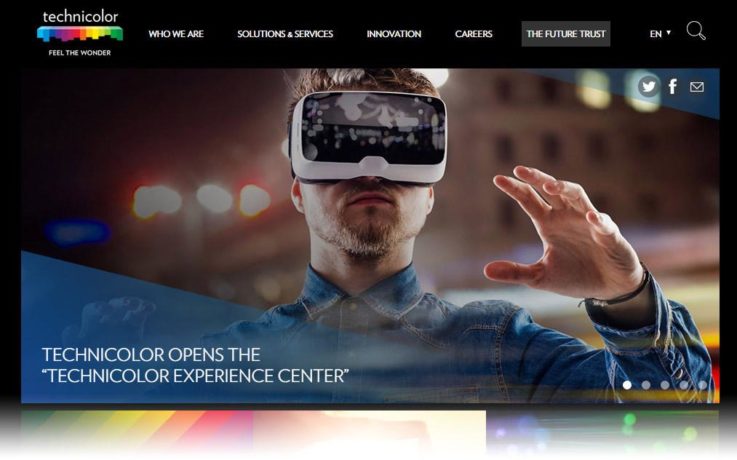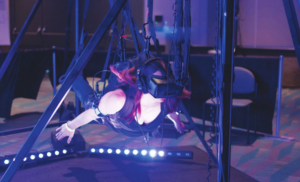Exclusives

M&E Journal: How Entertainment Will Be Altered by Immersive, New Consumer Experiences
Story Highlights
By Bob Eicholz, CTO Production Services, and Gaël Seydoux, R&I Lab Director, Technicolor
The interest, energy and excitement currently building up around entertainment experiences based on virtual and augmented reality (VR/ AR) is now palpable throughout the industry. Content creators, service providers and device manufacturers are all placing major bets that a new era of immersive reality will transform entertainment. In so doing, the industry is looking forward to new and profitable opportunities to connect more intimately than ever with consumers.
The excitement in the M&E industry about virtual and augmented reality is reflected by the optimism expressed across the spectrum of industry analysts who appear to be signaling that now is the time to make the immersive reality plunge. According to most analysts, 2016 is the year we will not only see new VR headsets launched, but also major rollout initiatives for broad consumer introduction.
ABI Research, for instance, believes the aggregate market for virtual reality devices will grow at an average combined annual growth rate (CAGR) of 106 percent between 2016 and 2020. By the end of the decade, the folks at ABI expect 43 million devices to be shipped per year. On the content side of the equation, Juniper projects that AR apps in the mobile games market will generate 420 million downloads annually by 2019, up from 30 million in 2014. Indeed, as many as 23 million American adults – or 11 percent of the online adult population – have already tried virtual reality according to YouVisit’s Virtual Reality Appetite Index.
These are all heady numbers that are based on sound analysis. That said, there is a tremendous amount of work for the entire ecosystem to engage in collaboratively if consumers are to see the full promise of immersive experiences available at the price points that will stimulate demand.
Engaging all senses
At Technicolor, we believe immersive reality represents a new art form altogether. Artists will have to understand what it means to engage all human senses (visual, audio, tactile… even smell). What we are already learning is that there is very little margin for error throughout the content creation, distribution and rendering process. The slightest performance anomaly not only disrupts the all-important willing-suspension-of-disbelief, but also creates a level of disorientation that can actually make people sick.
As a result, artists will not only have to develop an extremely high technical command of the new medium, but also establish a deeper biological understanding of how audiences respond to the multi-sensory experiences.
The role of three-dimensional sound will also play an extremely important role in the storytelling process, since it will likely be the key tool for engaging and properly focusing the attention of audiences who have a 360-degree field of vision within the experience. Mastering the technology to make people look up or down, left or right, or directly behind them when desired will be critical to maintaining some semblance of control over the narrative process.
The artistic palate is also expanded in immersive reality entertainment with the inclusion of haptic technologies that enable audiences to actually experience a sense of touch. Integrating these effectively into the process is a skill that must be mastered so that stories are advanced and enhanced; the risk of misusing haptic elements can cause distraction or cognitive dissonance.
These are just a sampling of the new skillsets that will have to be developed to create the next generation of compelling immersive reality experiences. But there is good news. While these are all new fields of knowledge and expertise, the highly evolved state of today’s filmmaking and videogaming industries offer a strong basis from which we can move forward. In short, our collective skills are 100 percent transferable.
Meeting technological milestones
From a science and technology perspective, immersive reality represents a new frontier of research and development that is extremely exciting. There is, however, pressure to reach a few key milestones as quickly as possible to ensure that these entertainment experiences effectively reach consumers between now and the end of the decade.
The industry desperately needs new immersive reality authoring tools that allow us to capture, manipulate and edit content so that we can deliver compelling experiences to global audiences. Specifically, we need to create intuitive tools that are interoperable so that they can be used by the entire creative community – and just as importantly – can be picked up by each ensuing link in the value chain to consumers in theaters, at home, or to where ever they happen to access content on mobile devices.
 This leads to the need for improved bandwidth management and optimization. The amount of bandwidth that is needed to get an experience to theaters, the home, or mobile devices is huge. This is because the 3D, 360-degree perspective associated with putting consumers inside the entertainment experience exponentially increases the amount of data that must be delivered.
This leads to the need for improved bandwidth management and optimization. The amount of bandwidth that is needed to get an experience to theaters, the home, or mobile devices is huge. This is because the 3D, 360-degree perspective associated with putting consumers inside the entertainment experience exponentially increases the amount of data that must be delivered.
Moreover, the image and sound fidelity that will have to be supported is extremely high. From a resolution perspective alone, it is likely that we will need to send far more than 4K resolution; we will need 8K or more…per eye. This has significant implications for the wired and wireless network infrastructure that will have to deliver this payload to consumers.
With massively higher payloads comes a requirement for better processing power in the home and on the go. We are going to need more computing power for whatever technologies catch the data from the network (such as set-top-boxes), and we will need to make sure that the display technologies (such as mobile phones, tablets and head mounted displays) can render and deliver these immersive reality experiences according to extremely demanding performance parameters.
A little further down the line, progress will have to be made in developing comprehensive haptic experiences that can be seamlessly integrated into the storytelling process. Work is even underway to develop olfactory and air motion technology to further enhance the compelling immersive experience for consumers.
New economics of immersive reality entertainment
As important as it is to master the art and science of immersive reality, it will be even more important to develop an end-to-end ecosystem that allows value to be aggregated and elevated as the experience works its way to the consumer.
Constructing effective industry-wide business models will be the only way to bring the market compelling, blockbuster immersive reality experiences that will be expensive to create, require significant enhancements to infrastructures, and drive the need for new innovations in customer premise equipment (CPE) and consumer electronics.
It is for this reason that we believe an ongoing and comprehensive, multi-disciplinary dialog needs to take place. If we are to bring the best and most demanded experiences to market, then the entire ecosystem will need to demonstrate a commitment to: 1) innovation in order to develop technologies that interoperate through the value-chain; 2) industrywide collaboration, to define business models that create opportunities for all segments of the value-chain; and 3) delivery of truly exceptional and engaging immersive experiences to consumers.
This last point is critical, because the expectations of consumers have truly been raised to stratospheric levels. If the content fails to meet these expectations, delivery is inadequate, or complexity is introduced at the point of consumption, then we put at risk the ability to deliver on the promise of immersive reality.
Click here to translate this article
Click here to download the complete .PDF version of this article
Click here to download the entire Spring 2016 M&E Journal









